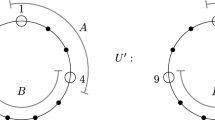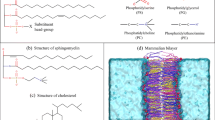Abstract
Stable mutants of Dede and CHO cells, resistant to suppression of cholesterogenesis by oxygenated sterols, have been isolated in a single step. Luria-Delbrück fluctuation analysis indicated a random occurrence of resistance at a rate of 1×10 −7 mutations/cell/generation. Cholesterol biosynthesis, 3-hydroxy-3-methylglutaryl coenzyme A reductase activity, and growth of the mutant cells were coordinately resistant to oxygenated sterols in the culture medium, and this resistance was expressed as a dominant traint in somatic cell hybrids of the wild-type and mutant cells. The dominant resistance was employed in the selection of various cell hybrids. There was complete additivity of reductase activities in mixed lysates of inhibited wild-type and uninhibited mutant cells, indicating that cytosolic (in)activation factors were not causative of this resistance. We suggest that oxygenated sterols are (co)repressors in suppression of the synthesis of the reductase and that the resistance mutant phenotypes result from altered regulatory loci.
Similar content being viewed by others
Literature cited
Rodwell, V.W., McNamara, D.J., and Shapiro, D.J. (1973).Adv. Enzymol. Relat. Areas Mol. Biol. 38:373–412.
Kandutsch, A.A., and Saucier, S.E. (1969).Arch Biochem. Biophys. 135:201–208.
Kandutsch, A.A., Heiniger, H.J., and Chen, H.W. (1977).Biochim. Biophys. Acta 486:260–272.
Gaylor, J.L. (1963).Arch. Biochem. Biophys. 101:108–119.
Chen, H.W., and Heiniger, H.J. (1974).Cancer Res. 34:1034–1307.
Chen, H.W., Kandutsch, A.A., Heiniger, H.J., and Meier, H. (1973).Cancer Res. 33:2774–2778.
Siperstein, M.D., Gyde, A.M., and Morris, H.P. (1971).Proc. Natl. Acad. Sci. U.S.A. 68:315–317.
Avigan, J., Williams, C.D., and Blass, J.P. (1970).Biochim. Biophys. Acta 218:381–384.
Brown, M.S., and Goldstein, J.L. (1974).J. Biol. Chem. 249:7306–7314.
Kandutsch, A.A., and Chen, H.W. (1973).J. Biol. Chem. 248:8408–8417.
Kandutsch, A.A., and Chen, H.W. (1974).J. Biol. Chem. 249:6057–6061.
Erikson, S.K., Matsui, S.M., Shrewsbury, M.A., Cooper, A.D., and Gould, R.G. (1978).J. Biol. Chem. 253:4159–4164.
Bell, J.J., Sargeant, T.E., and Watson, J.A. (1976).J. Biol. Chem. 251:1745–1758.
Breslow, J.L., Lothrop, D.A., Spaulding, D.R. and Kandutsch, A.A. (1975).Biochim. Biophys. Acta 398:10–17.
Gibbons, G.F., Pullinger, C.R., Chen, H.W., Cavenee, W.K., and Kandutsch, A.A. (1980).J. Biol. Chem. 255:395–400.
Kandutsch, A.A., Chen, H.W., and Heiniger, H.J. (1978).Science 201:498–501.
Cavenee, W.K., Gibbons, G.F., Chen, H.W., and Kandutsch, A.A. (1979).Biochim. Biophys. Acta 575:255–265.
Chen, H.W., Cavenee, W.K., and Kandutsch, A.A. (1979).J. Biol. Chem. 254:715–720.
Davidson, R.L., O'Malley, K.A., and Wheeler, J.B. (1976).Somat. Cell Genet. 2:271–278.
Baker, R.M., Brunette, D.M., Mankovitz, R., Thompson, L.H., Whitmore, G.E., and Till, J.E. (1974).Cell 1:9–21.
Ling, V., and Baker, R.M. (1978).Somat. Cell Genet. 4:193–200.
Chen, H.W., Kandutsch, A.A., and Waymouth, C. (1974).Nature 251:419–421.
Luria, S.E., and Delbruck, M. (1943).Genetics 28:491–511.
Beg, Z.H., Stonik, J.A., and Brewer, H.B. (1978).Proc. Natl. Acad. Sci. U.S.A. 75:3678–3682.
Gibson, D.M., and Ingebritsen, T.S. (1978).Life Sci. 23:2649–2664.
Saucier, S.E., and Kandutsch, A.A. (1979).Biochim. Biophys. Acta 572:541–556.
Thompson, L.H., and Baker, R.M. (1973). In (ed.), Prescott, D.Methods in Cell Biology, Vol. 7 (Academic Press, New York), pp. 209–281.
Kandutsch, A.A., Chen, H.W., and Shown, E.P. (1977).Proc. Natl. Acad. Sci. U.S.A. 74:2500–2503.
Kandutsch, A.A., and Thompson, E.B., (1980).J. Biol. Chem. 255:10813–10826.
Sinensky, M., and Mueller, G. (1981).Arch. Biochem. Biophys. 209:314–320.
Alt, F.W., Kellens, R.E., Bertino, J.R., and Schimke, R.T. (1978).J. Biol. Chem. 253:1357–1370.
Beirne, O.W., Heller, R.A., and Watson, J.A. (1977).J. Biol. Chem. 252:950–954.
Cavenee, W.K., Chen, H.W., and Kandutsch, A.A. (1981).J. Biol. Chem. 256:2675–2681.
Hardgrave, J.E., Heller, R.A., Herrera, M.G., and Scallen, T.J. (1979).Proc. Natl. Acad. Sci. U.S.A. 76:3834–3838.
Higgins, M., and Rudney, H. (1976).Nature 246:60–61.
Tomkins, G.M., Geleherter, T., Granner, D., Martin, D., Samuels, H., and Thompson, E.B. (1969).Science 166:1474–1480.
Sinensky, M. (1977).Biochem. Biophys. Res. Commun. 78:863–867.
Sinensky, M., Duwe, G., and Pinkerton, S. (1979).J. Biol. Chem. 254:4482–4486.
Sinensky, M., Armagast, S., Mueller, G., and Torget, R. (1980).Proc. Natl. Acad. Sci. U.S.A. 77:6621–6623.
Author information
Authors and Affiliations
Rights and permissions
About this article
Cite this article
Cavenee, W.K., Baker, R.M. Characterization of dominant hamster cell mutants resistant to oxygenated sterols. Somat Cell Mol Genet 8, 557–574 (1982). https://doi.org/10.1007/BF01542851
Received:
Revised:
Issue Date:
DOI: https://doi.org/10.1007/BF01542851




